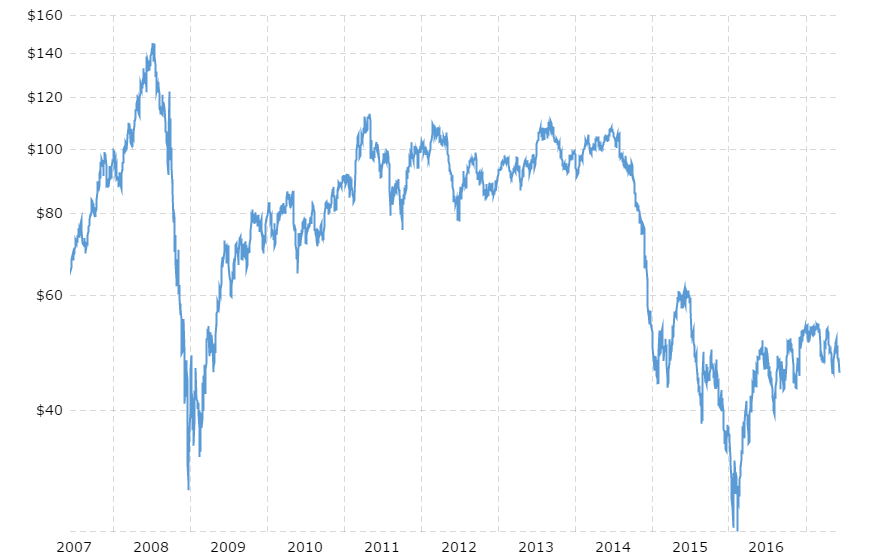Bearish sentiment has taken hold of crude oil prices as various analysts and agencies have slashed their forecast for this year and next. On Wednesday, oil fell a little over 5 percent to a one-month low of $45.72, taking the year-to-date loss to 15 percent. However, there has been a recovery on Thursday.
Abounding Bearishness
- Goldman Sachs recently cut its WTI crude oil price forecast for 2017 to $52.292 a barrel from its previous forecast of $54.80 a barrel.
- On the assumption that U.S. shale production would continue to increase this year and the next, and the OPEC production cuts would be rolled back by the end of the year, JPMorgan recently lowered it WTI oil price forecast for 2018 by a dramatic $11 to $42.
- The U.S. Energy Information Administration, in its monthly Short-Term Energy Outlook report released on June 6 lowered its WTI oil price forecast for 2018 by 2.7 percent to $53.61, premised on higher-than-forecast production. However, the agency nudged up its outlook for 2017 by 0.2 percent to $50.78.
No Smooth Ride For Oil Prices
After recording a gain of 45 percent in 2016, its biggest annual gain in seven years, oil held above the $50/barrel mark in January and February, trading in a range of $50.82 to $54.45. In early March, oil fell steeply to a low of $47.34. After making a comeback in April and touching a high of $53.40 on April 11, oil fell below the $47-a-barrel level in early May.
 Source: Macrotrends
Source: Macrotrends
The subsequent recovery attempt took it past $51, although the rally stalled shortly after amid renewed selling.
JJ Kinahan, chief strategist for TD Ameritrade, said he will keep an eye on the $44.5 level. Although oil price is not a drag on the overall market yet, Kinahan highlighted the historical perspective that at some point it did become a drag a few years ago.
Offering reasons as to why lower oil prices have not bothered the market thus far, Kinahan said the market is keyed into former F.B.I. director James Comey's testimony before the Senate Intelligence Committee. Additionally, traders may take heart from gas prices that have remained benign without pinching the pockets of consumers and the ongoing summer driving season, which could support prices.
What Has Changed Since Buoyant 2016
Black gold was supported in its ascent in 2016 by expectations concerning OPEC implementing a production cut, which materialized in November 2016. On May 25, 2017, OPEC extended the cuts by another 8 months. Ironically, the announcement failed to offer impetus to prices. a href="http://blog.jpmorganinstitutional.com/2017/05/opec-really-whatever-takes/"> Ebele Kemery, head of energy investing at JPMorgan Asset Management, believes the 8-month extension would cushion the oil prices.
"A nine month extension will increase the period of inventory draws, flipping 1Q18 balances from a build to a draw, ensuring that inventory normalization is reached. It will also cushion prices through seasonal weakness normally present in the first quarter of the year," Kemery said.
Kemery, however, is uncomfortable with OPEC's lack of conviction in conveying an exit strategy.
"Neither the length of the extension, nor the compliance rate of its participants, concerns me as much as OPEC's lack of an exit strategy. If OPEC really has the courage behind their convictions, then the optimal decision would have been to extend cuts through the end of 2018," Oil Price quoted Kemery as saying.
Supply Outlook Bearish For Prices
Even as OPEC presses ahead with the approximately 1.5 million barrels-per-day production cut, forecasts for rising non-OPEC production is expected to remain a threat to oil prices.
The EIA estimates U.S. oil production to average 9.3 million barrels per day in 2017, up from 8.9 mbd in 2016. It is set to rise further to 10 mbd in 2018, exceeding the 9.6 mbd record set in 1970.
Notwithstanding OPEC production cuts that would stay until March next year and the fairly robust demand outlook, oil prices are not expected to move much beyond the year's trading range, given the limited visibility into the OPEC's future course of action and the robust production expectations.
Asked when oil prices may begin to serve as a drag on markets, Kinahan said, "You start getting to 44.5 and that opens up 40 quickly." The analyst sees these two key levels as bogeys.
Related Links:
With Oil And Gas Earnings On Deck, A Trading Opportunity In Leveraged ETFs
© 2025 Benzinga.com. Benzinga does not provide investment advice. All rights reserved.
Trade confidently with insights and alerts from analyst ratings, free reports and breaking news that affects the stocks you care about.